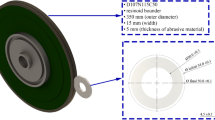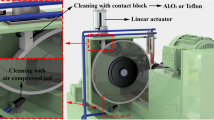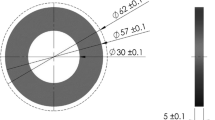Abstract
The sustainable industry is becoming a global trend that aims to align productivity, quality, and environmental preservation. In the grinding process, the need arises to develop new technologies to replace cutting fluids, which are highly toxic substances. The minimum quantity of lubrication (MQL) technique is alternative lubrication and cooling method that makes machining more ecological. However, its application is still tiny due to its low cooling power and cleaning of the workpiece-tool interface. On the other hand, the grinding conditions improve when associated with the wheel cleaning jet (WCJ) system, which consists of applying an inclined compressed air jet on the grinding wheel, avoiding clogging and the adhesion of chips on the surface of the grinding wheel. From this perspective, this work aims to perform a comparative analysis between the flood method and the MQL and MQL + WCJ techniques, in the external cylindrical grinding of alumina ceramic (Al2O3), at feed rates of 0.25, 0.50, and 0.75 mm/min. The output parameters analyzed will be diametrical wheel wear, G-ratio, surface roughness, roundness error, grinding power, cost, and pollution analysis. The G-ratio was 40% better using MQL + WCJ compared to MQL, while the grinding cost per piece with MQL + WCJ represented about 24% of the price of the conventional method. The results show that the association of WCJ to MQL improves the efficiency of the MQL technique, guaranteeing good results and being an eco-friendly technique.











Similar content being viewed by others
References
Malkin S, Guo C (2008) Grinding technology: theory and applications of machining with abrasives, 2aed. Industrial Press Inc, New York
Lopes JC, Ribeiro FSF, Linkevicius SAS et al (2022) Manufacturing process linked to the MQL compared to flood lubrication applied to the grinding of VP50IM steel using black silicon carbide wheel. Int J Adv Manuf Technol 120:4179–4190. https://doi.org/10.1007/s00170-022-08937-3
Rodriguez RL, Lopes JC, Hildebrandt RA et al (2019) Evaluation of grinding process using simultaneously MQL technique and cleaning jet on grinding wheel surface. J Mater Process Technol 271:357–367. https://doi.org/10.1016/j.jmatprotec.2019.03.019
Talon AG, de Souza RM, Garcia MV et al (2021) Comparative evaluation of CBN wheels with abrasive grains of different friability applied to steel and ductile iron grinding process. Int J Adv Manuf Technol. https://doi.org/10.1007/s00170-020-06456-7
Daniel DM, Ávila BN, Garcia MV et al (2020) Grinding comparative between ductile iron and austempered ductile iron under CBN wheel combined to abrasive grains with high and low friability. Int J Adv Manuf Technol 109:2679–2690. https://doi.org/10.1007/s00170-020-05787-9
de Moraes DL, Lopes JC, Andrioli BV et al (2021) Advances in precision manufacturing towards eco-friendly grinding process by applying MQL with cold air compared with cooled wheel cleaning jet. Int J Adv Manuf Technol 113:3329–3342. https://doi.org/10.1007/s00170-021-06713-3
Garcia MV, Lopes JC, Diniz AE et al (2020) Grinding performance of bearing steel using MQL under different dilutions and wheel cleaning for green manufacture. J Clean Prod 257:120376. https://doi.org/10.1016/j.jclepro.2020.120376
Debnath S, Reddy MM, Yi QS (2014) Environmental friendly cutting fluids and cooling techniques in machining: a review. J Clean Prod 83:33–47
Willing A (2001) Lubricants based on renewable resources – an environmentally compatible alternative to mineral oil products. Chemosphere 43:89–98. https://doi.org/10.1016/S0045-6535(00)00328-3
Talon AG, Lopes JC, Sato BK et al (2020) Grinding performance of hardened steel: a study about the application of different cutting fluids with corrosion inhibitor. Int J Adv Manuf Technol 108:2741–2754. https://doi.org/10.1007/s00170-020-05598-y
Lopes JC, Ávila BN, de Souza RM et al (2021) Grinding comparative analysis between different proportions of water-oil applied to MQL technique and industrial production cost towards a green manufacturing. Int J Adv Manuf Technol. https://doi.org/10.1007/s00170-021-06625-2
Madanchi N, Thiede S, Herrmann C (2017) Functional and environmental evaluation of alternative disinfection methods for cutting fluids. Procedia CIRP 61:558–563. https://doi.org/10.1016/j.procir.2016.11.175
Javaroni RL, Lopes JC, Sato BK et al (2019) Minimum quantity of lubrication (MQL) as an eco-friendly alternative to the cutting fluids in advanced ceramics grinding. Int J Adv Manuf Technol 103:2809–2819. https://doi.org/10.1007/s00170-019-03697-z
Nadolny K (2015) Small-dimensional sandwich grinding wheels with a centrifugal coolant provision system for traverse internal cylindrical grinding of steel 100Cr6. J Clean Prod 93:354–363. https://doi.org/10.1016/j.jclepro.2015.01.046
Gajrani KK, Ram D, Ravi Sankar M (2017) Biodegradation and hard machining performance comparison of eco-friendly cutting fluid and mineral oil using flood cooling and minimum quantity cutting fluid techniques. J Clean Prod 165:1420–1435. https://doi.org/10.1016/j.jclepro.2017.07.217
Javaroni RL, Lopes JC, Garcia MV et al (2020) Grinding hardened steel using MQL associated with cleaning system and cBN wheel. Int J Adv Manuf Technol 107:2065–2080. https://doi.org/10.1007/s00170-020-05169-1
Lopes JC, Garcia MV, Valentim M et al (2019) Grinding performance using variants of the MQL technique: MQL with cooled air and MQL simultaneous to the wheel cleaning jet. Int J Adv Manuf Technol 105:4429–4442. https://doi.org/10.1007/s00170-019-04574-5
Field M, Kegg R, Buescher S (1980) Computerized cost analysis of grinding operations. CIRP Ann 29:233–237. https://doi.org/10.1016/S0007-8506(07)61328-6
Lopes JC, Garcia MV, Volpato RS et al (2020) Application of MQL technique using TiO2 nanoparticles compared to MQL simultaneous to the grinding wheel cleaning jet. Int J Adv Manuf Technol 106:2205–2218. https://doi.org/10.1007/s00170-019-04760-5
Lopes JC, Fragoso KM, Garcia MV et al (2019) Behavior of hardened steel grinding using MQL under cold air and MQL CBN wheel cleaning. Int J Adv Manuf Technol 105:4373–4387. https://doi.org/10.1007/s00170-019-04571-8
Javaroni RL, Lopes JC, Diniz AE et al (2020) Improvement in the grinding process using the MQL technique with cooled wheel cleaning jet. Tribol Int 152:106512. https://doi.org/10.1016/j.triboint.2020.106512
Hammel EC, Ighodaro OL-R, Okoli OI (2014) Processing and properties of advanced porous ceramics: an application based review. Ceram Int 40:15351–15370. https://doi.org/10.1016/j.ceramint.2014.06.095
Xu S, Yao Z, Cai H, Wang H (2017) An experimental investigation of grinding force and energy in laser thermal shock-assisted grinding of zirconia ceramics. Int J Adv Manuf Technol 91:3299–3306. https://doi.org/10.1007/s00170-017-0013-y
Sato BK, Lopes JC, Rodriguez RL et al (2022) Novel comparison concept between CBN and Al2O3 grinding process for eco-friendly production. J Clean Prod 330:129673. https://doi.org/10.1016/j.jclepro.2021.129673
Kuffa M, Kuster F, Wegener K (2017) Comparison of lubrication conditions for grinding of mild steel with electroplated cBN wheel. CIRP J Manuf Sci Technol 18:53–59. https://doi.org/10.1016/J.CIRPJ.2016.09.002
Ribeiro FSF, Lopes JC, Garcia MV et al (2020) New knowledge about grinding using MQL simultaneous to cooled air and MQL combined to wheel cleaning jet technique. Int J Adv Manuf Technol 109:905–917. https://doi.org/10.1007/s00170-020-05721-z
de Jesus Oliveira D, Guermandi LG, Bianchi EC et al (2012) Improving minimum quantity lubrication in CBN grinding using compressed air wheel cleaning. J Mater Process Technol 212:2559–2568. https://doi.org/10.1016/j.jmatprotec.2012.05.019
Rodriguez RL, Lopes JC, Mancini SD et al (2019) Contribution for minimization the usage of cutting fluids in CFRP grinding. Int J Adv Manuf Technol 103:487–497. https://doi.org/10.1007/s00170-019-03529-0
Matthew S (2009) Metal working fluids: finding green in the manufacturing process. Ind Lubr Tribol 61:60–66. https://doi.org/10.1108/00368790910940374
Lopes JC, Ventura CEH, Fernandes L d M et al (2019) Application of a wheel cleaning system during grinding of alumina with minimum quantity lubrication. Int J Adv Manuf Technol 102:333–341. https://doi.org/10.1007/s00170-018-3174-4
Emami M, Sadeghi MH, Sarhan AAD, Hasani F (2014) Investigating the minimum quantity lubrication in grinding of Al2O3 engineering ceramic. J Clean Prod 66:632–643. https://doi.org/10.1016/j.jclepro.2013.11.018
de Martini FL, Lopes JC, Volpato RS et al (2018) Comparative analysis of two CBN grinding wheels performance in nodular cast iron plunge grinding. Int J Adv Manuf Technol 98:237–249. https://doi.org/10.1007/s00170-018-2133-4
Silva LR, Corrêa ECS, Brandão JR, de Ávila RF (2020) Environmentally friendly manufacturing: behavior analysis of minimum quantity of lubricant - MQL in grinding process. J Clean Prod 256:103287. https://doi.org/10.1016/j.jclepro.2013.01.033
Moretti GB, Ávila BN, Lopes JC et al (2021) Industrial manufacturing linked to the mechanical and economic viewpoint of the mold steel grinding process using aluminum oxide wheel. Int J Adv Manuf Technol 117:2655–2666. https://doi.org/10.1007/s00170-021-07827-4
De Mello BR, Júnior HF, Canarim RC et al (2014) Utilization of minimum quantity lubrication (MQL) with water in CBN grinding of steel. Mater Res 17:88–96. https://doi.org/10.1590/S1516-14392013005000165
Walker T (2013) MQL Handbook. Unist company
Huang X, Ren Y, Li T et al (2018) Influence of minimum quantity lubrication parameters on grind-hardening process. Mater Manuf Process 33:69–76. https://doi.org/10.1080/10426914.2016.1269916
Tawakoli T, Hadad MJ, Sadeghi MH (2010) Investigation on minimum quantity lubricant-MQL grinding of 100Cr6 hardened steel using different abrasive and coolant-lubricant types. Int J Mach Tools Manuf 50:698–708. https://doi.org/10.1016/j.ijmachtools.2010.04.009
Ribeiro FSF, Lopes JC, Garcia MV et al (2020) Grinding performance by applying MQL technique: an approach of the wheel cleaning jet compared with wheel cleaning Teflon and Alumina block. Int J Adv Manuf Technol 107:4415–4426. https://doi.org/10.1007/s00170-020-05334-6
Inasaki I, Karpuschewski B, Wehmeier M (2000) Grinding monitoring system based on power and acoustic emission sensors. CIRP Ann - Manuf Technol 49:235–240
Acknowledgements
The authors thank the Coordination for the Improvement of Higher-Level Education Personnel (CAPES) and the National Council for Scientific and Technological Development (CNPq) for funding this research, Dinser Ferramentas Diamantadas for donating the diamond grinding wheel, and Quimatic Tapmatic Ltda, and ITW Chemical Products Ltda for donating the cutting fluids.
Funding
This work was supported by the Coordination for the Improvement of Higher-Level Education Personnel (CAPES), National Council for Scientific and Technological Development (CNPq) (Grant PIBIC-2022/2023) and São Paulo Research Foundation (FAPESP) (Grant 2021/08549-8).
Author information
Authors and Affiliations
Contributions
Lucas de Martini Fernandes: writing the original draft; visualization; conceptualization; formal analysis; investigation; validation. Rafael Liberatti Javaroni: writing, review and editing; investigation; validation. Matheus de Souza Rodrigues: Software; writing, review and editing; investigation; validation. Benício Nacif Ávila: writing, review and editing; visualization; conceptualization; formal analysis; investigation; validation. Douglas Lyra de Moraes: writing the original draft; resources; conceptualization; methodology; project administration. Fernando Sabino Fonteque Ribeiro: writing, review and editing; visualization; conceptualization; Alessandro Roger Rodrigues: Conceptualization; methodology; formal analysis; investigation; validation. Thiago Valle França: formal analysis; investigation; validation. Luiz Eduardo de Angelo Sanchez: writing, review and editing; conceptualization; supervision. Eduardo Carlos Bianchi: funding acquisition; conceptualization; resources; supervision; project administration. José Claudio Lopes: supervision; project administration. All authors read and approved the final manuscript.
Corresponding author
Ethics declarations
Ethics approval
The authors declare that this manuscript was not submitted to more than one journal for simultaneous consideration. Also, the submitted work was original and has not been published elsewhere in any form or language.
Consent to participate and publish
The authors declare that they participated in this paper willingly, and the authors declare to consent to the publication of this paper.
Competing interests
The authors declare no competing interests.
Additional information
Publisher’s note
Springer Nature remains neutral with regard to jurisdictional claims in published maps and institutional affiliations.
Rights and permissions
Springer Nature or its licensor (e.g. a society or other partner) holds exclusive rights to this article under a publishing agreement with the author(s) or other rightsholder(s); author self-archiving of the accepted manuscript version of this article is solely governed by the terms of such publishing agreement and applicable law.
About this article
Cite this article
Fernandes, L.d.M., Javaroni, R.L., Rodrigues, M.d. et al. Advanced ceramic grinding process combined to hazard mitigation to the employees’ health by using an alternative lubri-refrigeration technique. Int J Adv Manuf Technol 127, 2921–2934 (2023). https://doi.org/10.1007/s00170-023-11674-w
Received:
Accepted:
Published:
Issue Date:
DOI: https://doi.org/10.1007/s00170-023-11674-w




